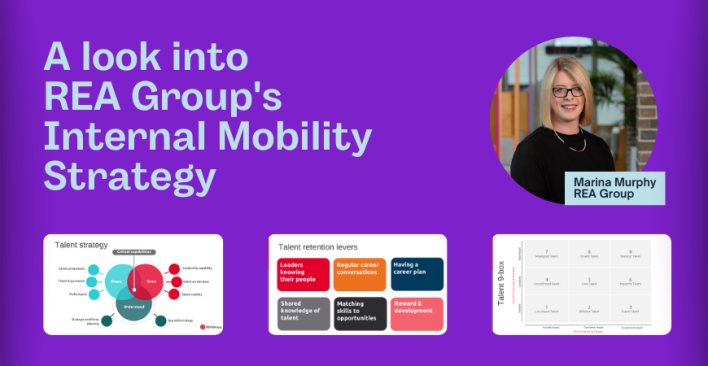What I learned about Talent pools: Exploring best practices with Rebekah Di Blasi from KJR

This week we are exploring Talent pools and learning from some of our local Talent leaders who are using this recruitment strategy to identify and cultivate great candidates to grow their Talent pipelines.
So how are they doing it? What are some of the best practices when it comes to creating and managing an active Talent pool? Next up, we have Rebekah Di Blasi, Head of Talent & Culture at KJR, here to share with us more on that and her organisation’s journey into Talent pools.
Why Talent Pools?
For a long time, KJR had been using an outdated Salesforce tool that was essentially just a database with limited functionality and an Excel spreadsheet to manage active candidates. It was a very manual process with information becoming outdated too quickly to keep up with the pace of recruitment within the organisation.
Furthermore, as a technology-focused strategic advisory firm we have client projects that frequently require us to ramp up quickly and demanding additional support at short notice. It is impossible to go to market for someone to start tomorrow and expect a good result.
For this reason, we knew that creating a Talent community and pooling potential candidates was always going to be the best approach for KJR, we just needed a tool to help us do it effectively. We also wanted to have ongoing conversations with potential Talent aligned to our future direction, even if we weren’t going to have relevant opportunities for them in the short term.
With exciting growth plans, this was an important aspect of our long-term Talent planning and continued marketing of our employer brand.
Best practices on creating effective Talent pools
ONE: Talent pools should be built around business-critical roles that you recruit for regularly or are niche and hard to fill. There is no point building a Talent pool for a role you are unlikely to recruit for or one with a large candidate market. Focus on roles that are aligned to your strategic workforce plan and are tough to find qualified Talent for.
TWO: Communication should be relevant and the frequency determined by the role. Different candidates are motivated by different things so what you would send an IT Grad won’t necessarily be appropriate for a potential CIO. Candidates also don’t want to be receiving emails every week so make sure the cadence of communication is appropriate. We touch base with our Talent pools on a quarterly, bi-annual or annual basis depending on the role, and more often for those who are actively looking and have requested more frequent updates.
THREE: Internal awareness of Talent pools is essential, don’t forget your internal audience as they can be a good source of referrals. Make sure your employees understand the types of roles you’re pooling for and regularly encourage them to refer quality candidates.
FOUR: Hiring Managers should have a good idea of who is swimming in their pools and agree with how candidates are being assessed and qualified. Take a shared approach when establishing each Talent pool so that you are pipelining the right candidates and Hiring Managers know where to look before being tempted to go to market.
Common misunderstanding about Talent pools
THE MISCONCEPTION: A Talent pool must be attached to an active, available position.
THE FACT: It can be attached to an organisation’s strategic planning over a longer period. At KJR, we know that digital transformation doesn’t happen overnight, and new disruptors are emerging every day. So, we have Talent pools aligned to known future requirements and even some roles that are our “best guess” given the emerging tech we’re working with!
We also align Talent pooling to succession planning, understanding our workforce and ensuring key roles have both internal and external Talent pipelined in case of attrition.
Advice for Talent leaders getting into Talent pools
The days of “post and pray” are over and the best Talent is not always found in response to an ad on a job board.
Top candidates are making decisions based on a company’s broader value proposition and culture, as much as the role and remuneration.
So, if you are not reaching out and starting an ongoing conversation about why they should choose to work for your organisation one day, you will stand no chance when that day arrives.
Taking a proactive approach will ensure you have suitable, qualified and engaged Talent ready to join as soon as the opportunity arises.
Read the rest of the articles in the Talent pool series:
What I learned about Talent pools: Busting myths with Jon Bowker from Roy Hill
What I learned about Talent pools: Reducing time-to-fill with Andy Gooden from Little Real Estate
Cover image: KJR
Struggling to gain visibility & control over your workforce? Join us at the Contingent Workforce Workshop 2018 in Melbourne or Sydney to learn the skills, models and case studies you need to solve these challenges!

Related articles
One Response to “What I learned about Talent pools: Exploring best practices with Rebekah Di Blasi from KJR”
Leave a Reply
Sign up to our newsletter
Get a weekly digest on the latest in Talent Acquisition.
Deliver this goodness to my inbox!



Nice article. Can you please share some names of technology platforms or products for Talent pooling and engagement.